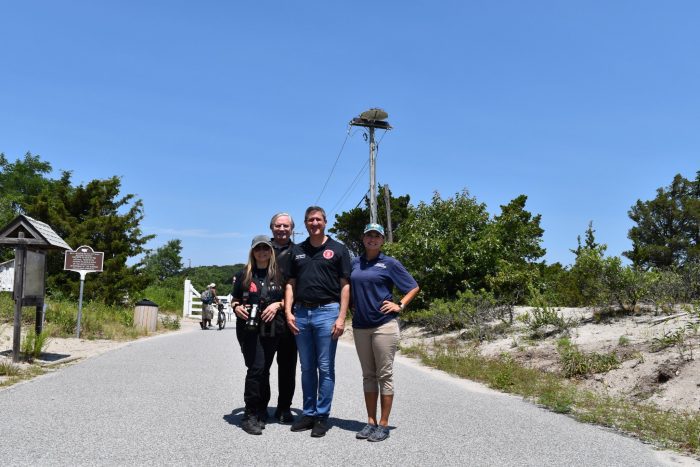By John L. Turner
In the early evening of a mid-June day, eleven intrepid participants hiked through the globally rare Dwarf Pine Plains, a unique forest of pygmy pines found in the Long Island Pine Barrens. Their mission? To hear the night-time calls of the “moonbirds” — Whip-poor-wills and Chuck-will’s-widows (or “whips” and “chucks” in birding vernacular), ringing out over the dwarf pines. For these nocturnal birds, the central Pine Barrens is their Long Island stronghold.
We know for the Whip-poor-will, and suspect for the Chuck-will’s-widow, their reproductive cycle is tied to the phases of the moon. “Whips” typically mate shortly after the full moon in May and the young hatch about 10 days before the next full moon in June. As the moon moves through its waxing phase and its reflected light gains in strength, whip-poor-wills can see better at night enabling them to hunt more efficiently for the moths and large beetles they eat and feed to their young. During this active time both species vocalize, their onomatopoeiac calls repeated often — one student reported a whip-poor-will calling 1,088 times consecutively! No wonder their common names were derived from the calls they make!
While their calls were very much appreciated by the night’s participants, it hasn’t always been the case their calls were welcome sounds. Superstition and meaning abound. A popular belief claimed that whoever hears a whip-poor-will will soon die; a variation portends a death of someone the listener knows. Or a whip-poor-will calling outside a house meant the death of an inhabitant, and perhaps, allowing the bird to grab their soul as it departs their body, which if they did would lead to further calling by the bird. If the bird failed in capturing the soul it would fall silent. Other legends imparted only bad luck but not death to the hearer of a call.
Another legend has it that a person with back ailments who does somersaults in cadence with the whip-poor-will’s call will see their back problems soon cured (makes you wonder, though, if a person could do somersaults every two to three seconds then maybe their back wasn’t in such bad shape to begin with?).
Another “first of the year call” legend meant good luck — if you made a wish upon hearing your first call then that wish would come true. In Louisiana gardeners would use the date of the first call of the whip-poor-will as a guide to planting garden peas.
According to folklore legend, whip-poor-wills had importance to single women. If an unhitched woman heard her first whip-poor-will call of the year but the bird then went immediately silent, she would stay single all year long; but if she was quick enough to wish to be married upon hearing the call she would soon be so. Still another legend notes that if a single woman hears a whip-poor-will call before morning light and another whip-poor-will responds, her “future man” will think of her that day.
Native Americans were also intrigued by whip-poor-wills. The Iroquois, for example, believed that moccasin flowers (pink lady’s slippers) were the shoes of whip-poor-wills while Utes believed whip-poor-wills were gods of the night.
Henry David Thoreau had a different, more basic take on a whip-poor-will’s call: “It could mean many things, according to the wealth of myth surrounding this night flyer. The note of the whippoorwill borne over the fields is the voice with which the woods and moonlight woo me” he said.
“Whips” and “Chucks” belong to a group of birds known as “goatsuckers”, a name derived centuries ago from the mistaken belief they use their large, supple, flesh-lined mouths to suck on the teats of goats. They were even accused of blinding or killing livestock once they latched on! This perception of “goat-sucking” isn’t totally off-base since the goatsucker name developed in Europe where residents often observed European nightjars flying around goat pens. They weren’t there to latch onto goat teats but rather were likely attracted to the insects stirred up by the goats.
Even the family of birds these species belong to — the Caprimulgidae —underscore this mistaken connection. Capra in Latin means goat and mulgare means “to milk”. Even a very wise person, Aristotle, apparently believed the bird-goat connection noting: “Flying to the udders of she-goats, it sucks them and so it gets its name”.
In addition to Whip-poor-will’s and Chuck-will-widow’s there are six other members belonging to this family in North America — Buff-collared Nightjar, Common Poorwill, Common Pauraque and Common, Lesser, and Antillean Nighthawks — and three occur on Long Island — “whips”, “chucks” and Common Nighthawks. This latter species is a very rare breeder on Long Island, if at all, but passes through in fall migration in the low thousands, as evidenced by the recent annual totals at the Nighthawk Watch conducted at the Stone Bridge in Frank Melville Memorial Park in Setauket by the Four Harbors Audubon Society.
These North American goatsuckers can be grouped into two categories: nightjars and nighthawks. “Whips” and “chucks” are nightjars — they have more rounded wings and plumper bodies than their nighthawk brethren, and also have large rictal bristles lining each side of their mouths, similar to cat whiskers, that assist them in catching larger prey. Nighthawks lack these bristles which are actually highly modified feathers.
While nighthawks like the Common Nighthawk generally feed on small aerial insects as they zip around — gnats, midges, mosquitoes, and the like — nightjars, so called due to the jarring call of some species, feed on larger insects, bigger moths and beetles mostly, flying up from the ground or from a perch. Chuck-will’s-widows are also known to eat birds and lizards. When viewed in a picture the birds appear to possess small mouths because of their small bills. But looks can be deceiving as their mouths are enormous. In fact, the genus Antrostomus means “cavern mouth”.
One of the distinctive features of both “whips” and “chucks” are their cryptic coloration. They blend in remarkably well with the leaf litter on the forest floor, a good thing since they are ground nesting birds and they and their eggs (typically two) and chicks are more vulnerable to predation.
There is available on the Internet one photograph of a whip-poor-will on the forest floor and it is simply indistinguishable, in another closer photo the bird is partially revealed; it’s not until a second, even closer photo that the bird’s face and elongated body can be clearly seen.
This ground nesting habit is one reason why both species have declined. As Long Island becomes more developed and natural areas get fragmented by development, animals associated with that development — namely dogs, feral and free ranging pet cats, and wild animals such as raccoons attracted to easier food in suburban areas — frequent wild areas adjacent to the homes preying on a variety of vulnerable species including these nightjars.
A reduction in the abundance of their insect prey appears to be another contributing cause. From 1980-1985 New York conducted its first statewide breeding bird survey; it replicated the effort in 2000-2005. In the first survey whip-poor-wills were detected in 564 quadrangles (one square mile of land); in the latter survey the species was detected in only 241 quadrangles, a reduction of 57%. A similar trend occurred with the Chuck-will’s-widow, with a 62% reduction. A third bird survey began in 2020 and will be completed in 2025; at that time we’ll have an up-to-date picture of the status of these two nightjars.
Contrast this with John James Audubon’s 1838 account: “Hundreds are often heard at the same time in different parts of the woods, each trying to out-do the others; and when you are told that the notes of this bird may be heard at the distance of several hundred yards, you may form an idea of the pleasure which every lover of nature must feel during the time when this chorus is continued. Description is incapable of conveying to your mind any accurate idea of the notes of this bird, much less of the feelings which they excite”.
As I walked back to the car, ruminating about the experience of the “moonbirds” calling beneath the Strawberry Moon, some close enough to cause excitement, a random thought popped into mind — how human experience can be so enriched when we connect with other forms of life we allow to co-exist. May whip-poor-wills and chuck-will’s-widows call under full moons for many decades to come, serving all the while as harbingers of life, not death.
A resident of Setauket, John Turner is conservation chair of the Four Harbors Audubon Society, author of “Exploring the Other Island: A Seasonal Nature Guide to Long Island” and president of Alula Birding & Natural History Tours.
























